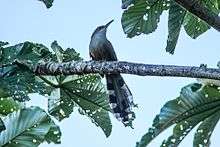Puerto Rican lizard cuckoo
The Puerto Rican lizard cuckoo (Coccyzus vieilloti) is a cuckoo endemic to the island of Puerto Rico, and is one of 4 species of lizard-cuckoos which occur only on Caribbean islands. These were formerly placed in the genus Saurothera (Greek for "lizard-eater") of the family Cuculidae, but are now lumped with Coccyzus (AOU 2006).
| Puerto Rican lizard cuckoo | |
|---|---|
 | |
| Scientific classification | |
| Kingdom: | Animalia |
| Phylum: | Chordata |
| Class: | Aves |
| Order: | Cuculiformes |
| Family: | Cuculidae |
| Genus: | Coccyzus |
| Species: | C. vieilloti |
| Binomial name | |
| Coccyzus vieilloti Bonaparte, 1850 | |
The binomial name of the Puerto Rican lizard cuckoo species commemorates French ornithologist Louis Jean Pierre Vieillot.
The Puerto Rican lizard cuckoo occurs in forests (common in the Guánica, Guajataca and Vega State Forests and in the Caribbean National Forest) and coffee plantations throughout the island of Puerto Rico. The species can be observed slowly foraging the forest understory for lizards, its main dietary component (approximately 75%). Large spiders and insects are consumed to supplement its diet.
Cuckoos are slender birds with long tails and long, thin, slightly curved bills. They move very slowly foraging for prey through the forest. Cuckoos do not swoop or circle in flight but generally fly in a direct line.
Description
The Puerto Rican lizard cuckoo has a gray breast and chin, a tan lower body and brown upper body. It can be identified by its gray chin and breast and reddish-tan underbelly. The main identifying characteristic for this species is its long dark tail with two white spots on its outer tail feathers. It measures from 40 to 48 centimeters (16 to 19 inches) and weighs, on average, 80 grams (2.7 ounces).
Habits
The Puerto Rican lizard cuckoo moves slowly through the vines and thickets of the middle story and upper canopy of the rain forest foraging for prey. Its favorite food source (and the bulk of its diet) is provided by the abundant lizard population in the forest. It also eats large spiders, beetles, stick bugs and caterpillars. The cuckoo often keeps its body still while it twists its neck at angles to strike its prey. This bird is often difficult to see because of its slow movement through the foliage, but after it rains it can sometimes be seen in the open drying-off and preening its feathers. Its song is a rapid cow-cow-cow-crrk, not unlike the sound a Halloween witch makes. The cuckoo nest is a twig platform in a tree or large bush and usually contains up to 3 blue eggs.
Habitat
The Puerto Rican lizard cuckoo is endemic to (only found in) Puerto Rico. It is found in forest thickets, woodlands and coffee plantations throughout the island.[2]
See also
- Fauna of Puerto Rico
- List of birds of Puerto Rico
- List of endemic fauna of Puerto Rico
- List of Puerto Rican birds
- List of Vieques birds
- El Toro Wilderness
References
| Bird call | |
- BirdLife International (2012). "Coccyzus vieilloti". IUCN Red List of Threatened Species. 2012. Retrieved 26 November 2013.CS1 maint: ref=harv (link)
- http://www.fs.usda.gov/wps/portal/fsinternet/!ut/p/c5/04_SB8K8xLLM9MSSzPy8xBz9CP0os3gDfxMDT8MwRydLA1cj72DTUE8TAwgAykeaxRtBeY4WBv4eHmF-YT4GMHn8usNB9uHXDzYBB3A00PfzyM9N1S_IjTDIMnFUBADW0rdA/dl3/d3/L2dJQSEvUUt3QS9ZQnZ3LzZfMjAwMDAwMDBBODBPSEhWTjJNMDAwMDAwMDA!/?navtype=BROWSEBYSUBJECT&cid=fsbdev3_043055&navid=150130000000000&pnavid=150000000000000&ss=110819&position=Not Yet Determined.Html&ttype=detail&pname=El Yunque National Forest- Nature

- Oberle, Mark W., 1999; Birds of Puerto Rico in Photographs, Editorial Humanitas, San Juan, Puerto Rico, 1st Edition.
- Raffaele, Herbert W., 1989; A Guide to the Birds of Puerto Rico and the Virgin Islands, Princeton University Press, Princeton, New Jersey, USA
- Oberle, Mark (2003). Las aves de Puerto Rico en fotografías (in Spanish). Editorial Humanitas. p. 14. ISBN 0-9650104-2-2.
- Mowbray, Alan. "Wildlife facts - Puerto Rican Lizard Cuckoo". USDA Forest Service. Retrieved June 25, 2006.
